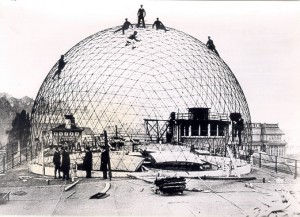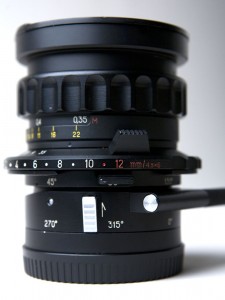By Guest Blogger Andy Bowley. This post is best read in conjunction with Andy’s piece about testing his Canon 5D Mark II DSLR camera and various lens for our shoot in Waco, Texas.
I can probably blame Philip Bloom for getting me interested in these behind-the-iron-curtain lenses. A while back he wrote about using the Hartblei Super Rotator, a Ukranian-built lens that could tilt and shift and rotate 360 degrees, very useful for selectively expanding and limiting areas of focus in frame. I was obsessed with finding one, and very happy to land a 40mm f3.5 at a photo shop in Barcelona. Only trouble was, when I got it home I discovered that it would not mount to the Contax ring of my Letus adapter–not being a still photographer, I failed to realize there were two kinds of Contax mounts.
After some research I decided to go down a different path to getting a tilt lens setup (I had no need for shift, really). I discovered that there were lots of very fine medium format lenses manufactured, like the Hartblei, with Pentacon Six mounts (a now-obscure mount popular with the Eastern Bloc set) that could be mounted to a tilt adapter. Best among them were the Zeiss lenses manufactured at the original Jena factory.

During the American withdrawal in 1945, the town of Jena (and the Zeiss factory) increasingly fell under Soviet influence. After “firm encouragement” from the Americans, some Zeiss technology and engineering staff were spirited out to a new site in Oberkochen–the site of the legendary Zeiss lens factory most of us Western folks know today. The two factories collaborated for a while, but as time went on, they began to innovate and manufacture independently. The Zeiss Oberkochen factory made lenses for western cameras; the Zeiss Jena factory, lenses for Eastern Bloc cameras, like the tankish Pentacon Six.
The Pentacon Six camera was manufactured at the Arsenal factory in Kiev. Arsenal also produced some nice lenses (though the quality control has often been described as hit-or-miss). I particularly like the Mir 26B 45mm f3.5, the lens is built from same elements as old Hartblei Super Rotator. I also like the Zeiss Jena 80mm f2.8, which tests well against the very best western primes. I used both lenses with Pentacon Six extension tubes and a Pentacon Six to Nikon tilt adapter. (These are manufactured by both Arsenal and Hartblei.)
Best source for the Pentacon Six stuff is still Ebay – German Ebay is even better/cheaper if you can manage the language barrier and ultra-slow shipping.

Using this setup requires lots of light. The extension tubes have a heavy exposure factor (roughly two stops in the configuration I used), and with such a tiny depth of field, it’s not advisable to shoot anywhere near wide open. I used a Rifa 66 softlight, hovering just out of frame with a 1k globe inside, giving me enough light to stop down to a f5.6 or more. I also made use of a tilt adapter, selectively adding depth of field on one axis when I could.
Working with macro is tweaky. With a depth of focus of just a millimeter or two, it is hugely helpful to have the ability to move the subject easily, or better, to move camera along focal axis on some kind of sliding device, like a macro rail — or in my case, a Kessler pocket dolly.
Equipment List for Macro Test
Canon 5D Mark II DSLR
Zacuto Pro Finder
Fotodiox Nikon to Canon adapter ring
Zeiss 80mm f2.8 Biometar
Arsenal Mir 26B 45mm f3.5
Arsenal Pentacon Six to Nikon tilt adapter
Arsenal Pentacon Six “automatic” extension tubes
Lowell Rifa 66 with 1k globe.
Miller Solo DV legs.
Manfrotto 75mm half-ball adapter (great for quickly leveling Pocket Dolly)
Kessler Traveler Pocket Dolly with Giottos MH-621 quick release
Velbon PH-368 fluid head.
*if you use the Manfrotto ball adapter with Miller legs and Pocket Dolly, put a big washer between the dolly and adapter – this will allow slider to get past top edge of legs.
If you want to read more about the Pentacon Six system, check out the superb pentaconsix.com website.
Links
tests well
===
Andy Bowley is a NYC-based cinematographer whose projects have won many national Emmys and one Peabody, but he considers the coolest thing on his mantle to be an old Pentacon six medium format camera, which now sits next to his beloved Manhattan pinecone. He has found a lot of other things while running through wooded sections of Central Park, but doesn’t want to talk about it.
E-mail Andy: a b o w l e y at e a r t h l i n k d o t n e t
What’s A Life’s Work about? It’s a documentary about people engaged in projects they won’t see completed in their lifetimes. You can find out more on this page.
We recently ran a crowdfunding campaign and raised enough to pay an animator and license half of the archival footage the film requires. We need just a bit more to pay for licensing the other half of the archival footage, sound mixing, color correction, E&O insurance and a bunch of smaller things. When that’s done, the film is done! It’s really very VERY close!
So here’s how you can help get this film out to the world. It’s very simple: click the button…
Donate Now!
… and enter the amount you want to contribute (as little as $5, as much as $50,000) and the other specifics. That’s it. No login or registration required. Your contribution does not line my pocket; because the film is fiscally sponsored by the New York Foundation for the Arts, all money given this way is overseen by them and is guaranteed to go toward the completion of this film. Being fiscally sponsored also means that your contribution is tax-deductible. So why not do it? The amount doesn’t matter as much as the fact that you’re helping to bring a work of art into the world. And that, I think, is really exciting!
Questions? Email me at d a v i d ( aT } b l o o d o r a n g e f i l m s {d o t] c o m


